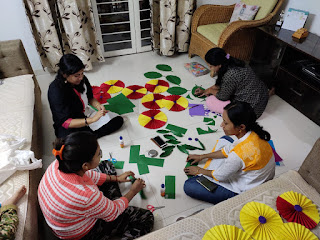With inputs from Shilpi Banerjee
Photographs by Arijit Banerjee
We celebrated Saraswati Puja in our apartment complex on Jan. 29. The festival brought a lot of positivity and joy to hearts, and hopefully contributed to a general view of learning, science and arts as something pure and pious.
 |
| The goddess and the priest |
As I have been pointing out the environmental aspect of community events in our neighbourhood, I think it would be good if I apply the same scrutiny on something we organised. So, here we go:
Decoration
We mostly used paper, flowers and leaves for decoration. The drapery used as a backdrop was reusable and went back to the tent house. The organic waste goes to the central organic waste disposal of our apartment.
After the puja, we ourselves removed the decoration. We created three heaps of waste: organic, recyclable and reject (very little). What remained were mostly work of art and craft done by ourselves. We retained them.
 |
| During decoration - 1 |
 |
| During decoration - 2 |
 |
| Drawings and paper decoration |
 |
| Outdoor flower decoration |
Idol
The goddess idol was a clay one; no plaster of paris or plastic. The idol was painted using organic colour and accessories were stuck using organic adhesive. After Puja, we did the immersion in a drum normally used within the society for sundry construction work. The drum, though not of a very presentable appearance, was very clean and hygienic. It was orders of magnitude cleaner than most ponds and lakes. We used freshwater for immersion. After immersion, the water and the dissolved clay was used in the society garden. The non-degradable parts of the idol, e.g. the clothing, hair and crown, were extricated and retained.
 |
| Goddess Saraswati |
 |
| The immersion drum (PC: Mrs. Sudeshna Banerjee) |
 |
| During immersion |
 |
| After immersion (PC: Mrs. Sudeshna Banerjee) |
 |
| Left over hair and accessories |
Prasad
Much of the morning time prasad was served in biodegradable plates. However, we eventually ran out of them and were forced to use paper (foil filmed) plates which are non-eco-friendly.
Lunch
Main course of the lunch was served in biodegradable betel leaf plates and spoons. Sweet Dahi was served in earthen pots, rosogolla was served directly on the plate.
Lunch being the most real time, populated and probably the most sensitive aspect of the festival, saw a few points of failures.
Towards the end of the queue, we ran out of plates. Eventually, we had to arrange more plates which were, unfortunately, not bio-degradable. Since all used plates ended up in the same bin, it all turned into reject waste. This was a bad failure for us.
Water was served in use-and-throw plastic bottles.
Number of people taking lunch was kept track of using lunch coupons generated out of the payment records. No paper coupons were printed. Of course, on the ground, most people having lunch were friends and acquaintances. Hence, the coupons were not used.
Waste Management
Amid her many tasks, my wife Shilpi was continually keeping an eye on the way waste was being managed on the puja venue. She ensured that all organic waste generated from the process was kept segregated from non-biodegradable waste. When we finally left the puja hall after cleaning up in the night, we had three neat heaps of waste: organic, recyclable and reject.
One failure on our part was that we couldn't ensure that the above segregation was honoured by the waste collection people when they picked it up in the morning. This happened primarily because none of us was available onsite at the time of clearing of waste.
Conclusion
Though not directly related to the environment, let me mention that the surplus fund (which was of course rather tiny at this scale) was donated to fund the education of one poor child through Akshay Patra foundation: as a tribute to the Goddess of knowledge a small deed of kindness to make knowledge accessible to one more person.
Overall, I think, we did set a good example of an eco-friendly celebration. Not so much because we didn't create any pollution at all, but because we paid attention to this aspect, and at least a few members of the team consciously worked hard to ensure that this aspect was not forgotten as unimportant. And it showed in the output.
Overall, I think, we did set a good example of an eco-friendly celebration. Not so much because we didn't create any pollution at all, but because we paid attention to this aspect, and at least a few members of the team consciously worked hard to ensure that this aspect was not forgotten as unimportant. And it showed in the output.
We couldn't prevent being eco-unfriendly in some aspects. I think, we will do better in future through better planning, more explicit buy-in from the organising committee and better communication to all participants.
For celebrations of larger magnitude, the organising committee should appoint one person who keeps an eye of the environmental footprint of the entire event. Of course, such a person should be passionate about sustainability. As much of his/her responsibility will involve making other people's work a bit harder (at least that's how many would perceive it), he/she will have to mentally sign up to earn a bit of unpopularity amidst other organising committee members and public. However, such a member's role will exceed in importance to most others'. By paying special attention to sustainability, organisers of large festivals and gatherings can make a big difference to the level of pollution that such events create.
Sustainability is going to be the key mantra of future public events. Because that's precisely where we tend to forget about the planet we live in and what we are doing to our habitat through our unsustainable lifestyle.


2 comments:
Very Nice. One touch of nature makes the whole world kin.
Hats of to your team for putting up the show so nicely! Intricate planning and focussing minutely even on minor details highlights the success of the event!
Post a Comment